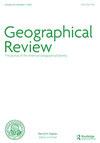GEOPANDERING
IF 1.4
3区 社会学
Q2 GEOGRAPHY
引用次数: 0
Abstract
Abstract Postage stamps are information products of a state that reflect how the state wishes to present its place in the world. Two changes in stamp production may affect this self-presentation. “Geopandering” (place manipulation) is an extreme form of self-promotion. Stamps of many small and relatively poor sovereignties account for most geopandered stamps, which have little or nothing to do with the sovereignty’s culture, history, or place in the world. Driven by the profit motivation to produce stamps for a worldwide clientele of collectors, these stamps serve as a source of revenue that is contractually shared with the private sector company that designs, produces, markets, and/or distributes them. A second construct is “hypernationalism,” which refers to an extreme focus on indigenous themes, people, places, and events with less concern about the intrinsic appeal of these stamps to worldwide collectors. More benign forms of hypernationalism are nothing new. Most stamps issued before the 1960s were of this type—celebrations of domestic achievements, events, and personalities that served both educational functions and “banal nationalism”—an often taken-for-granted and overlooked means of reinforcing patriotism and loyalty to the state. We illustrate the concepts of geopandering and hypernationalism using examples of stamps from different countries.邮票是一个国家的信息产品,反映了这个国家希望如何展示它在世界上的地位。邮票制作的两个变化可能会影响这种自我呈现。“地理漫游”(地点操纵)是一种极端的自我推销形式。许多小国和相对贫穷的主权国家的邮票占了大部分的邮票,这些邮票与主权国家的文化、历史或在世界上的地位几乎没有关系。在为世界各地的收藏者生产邮票的利润动机的驱使下,这些邮票作为收入的一个来源,与设计、生产、销售和/或分销邮票的私营公司签订合同。第二种结构是“超级民族主义”,指的是极度关注本土主题、人物、地点和事件,而不太关心这些邮票对全球收藏者的内在吸引力。更温和形式的超级民族主义并不是什么新鲜事。20世纪60年代以前发行的大多数邮票都是这种类型的——庆祝国内的成就、事件和人物,既具有教育功能,又具有“平庸的民族主义”——这是一种经常被视为理所当然的、被忽视的增强爱国主义和对国家忠诚的手段。我们以不同国家的邮票为例,说明“地球漫游”和“极端民族主义”的概念。
本文章由计算机程序翻译,如有差异,请以英文原文为准。
求助全文
约1分钟内获得全文
求助全文
来源期刊

Geographical Review
GEOGRAPHY-
CiteScore
4.80
自引率
10.00%
发文量
24
期刊介绍:
One of the world"s leading scholarly periodicals devoted exclusively to geography, the Geographical Review contains original and authoritative articles on all aspects of geography. The "Geographical Record" section presents short articles on current topical and regional issues. Each issue also includes reviews of recent books, monographs, and atlases in geography and related fields.
 求助内容:
求助内容: 应助结果提醒方式:
应助结果提醒方式:


